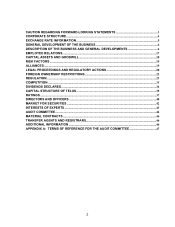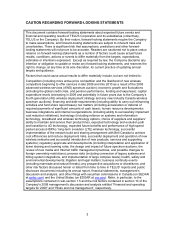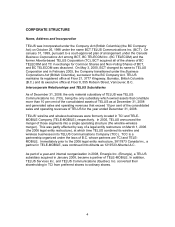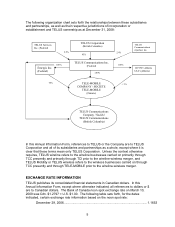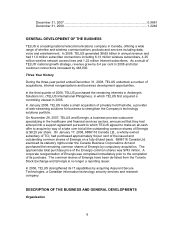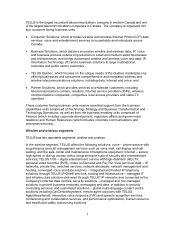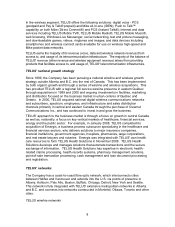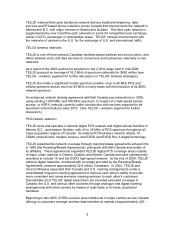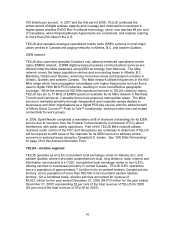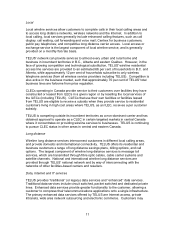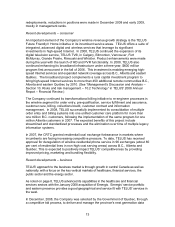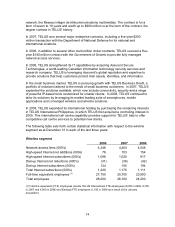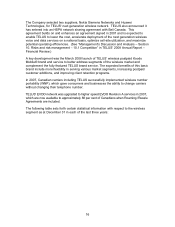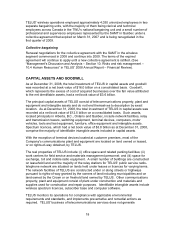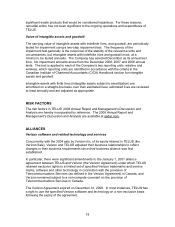Telus 2008 Annual Report Download - page 9
Download and view the complete annual report
Please find page 9 of the 2008 Telus annual report below. You can navigate through the pages in the report by either clicking on the pages listed below, or by using the keyword search tool below to find specific information within the annual report.TELUS’ national fibre optic backbone network delivers traditional telephony, data
services and IP-based phone solutions across Canada that interconnects the network in
Alberta and B.C. with major centres in Ontario and Québec. This fibre optic network is
supplemented by new local fibre optic networks in some 54 competitive local exchange
carrier (CLEC) exchanges or metropolitan areas. TELUS’ network interconnects with
the networks of carriers in the U.S. for the exchange of U.S. and international traffic.
TELUS wireless networks
TELUS is one of three national Canadian facilities-based wireless service providers, and
offers wireless voice and data services to consumers and businesses nationally on two
networks.
As a result of the AWS auction for spectrum in the 2 GHz range held in mid-2008,
TELUS acquired an average of 16.2 MHz of spectrum nationally for $882 million (see
TELUS – wireless segment for further discussion on TELUS’ wireless strategies).
TELUS also holds a significant mobile spectrum position of up to 45 MHz PCS and
cellular spectrum and as much as 55 MHz in many areas with the inclusion of its iDEN
network spectrum.
An enhanced network sharing agreement with Bell Canada was entered into in 2008,
using existing 1,900 MHz and 850 MHz spectrum, in respect of a high-speed packet
access, or HSPA, network currently under construction with services expected to be
launched commercially by early 2010. (See TELUS – wireless segment for further
discussion.)
PCS/cellular networks
TELUS owns and operates a national digital PCS network and digital cellular facilities in
Alberta, B.C., and eastern Québec, with 40 to 45 MHz of PCS spectrum throughout all
major population regions of Canada. Its national PCS wireless network utilizes 1X,
CDMA (code division multiple access), and EVDO and EVDO Rev A digital technology.
TELUS expanded its network coverage through roaming/resale agreements entered into
in 1999 (the Roaming/Resale Agreements), principally with Bell Canada and certain of
its affiliates. These agreements expanded TELUS’ digital PCS coverage areas outside
of major urban markets in Ontario, Québec and Atlantic Canada and were subsequently
amended to include 1X and the EVDO high-speed network. At the end of 2008, TELUS’
national digital networks, combined with coverage provided by the Roaming/Resale
Agreements, reached approximately 32.6 million Canadians. In 2004, TELUS and
Verizon Wireless expanded their Canada and U.S. roaming arrangements under a
consolidated long-term roaming agreement to improve each other’s ability to provide
more consistent and comprehensive roaming services to each other’s customers.
Substantially all of TELUS’ digital subscribers are provided extended coverage in
Canada, the U.S. and various other countries through analogue and digital roaming
arrangements with other carriers by means of dual-mode or tri-mode, dual-band
handsets.
Beginning in late 2005, EVDO services were introduced in major centres across Canada
offering to customers average wireless data transfers at speeds of approximately 400 –
9


